
Extraordinary Butterfly bushes
Discover original varieties of the butterfly bush
Contents
Buddleia or butterfly bush is more of a bush appreciated for its long nectariferous flowering, which earns it its charming nickname. Its trailing and arching habit fits perfectly into country gardens, seaside gardens, and naturalistic gardens. While we all recognise the flowering in the form of terminal spikes and the lavender to violet or white colour of Buddleia davidii, some cultivars or species truly stand out with their unusual flowering, unique foliage colour, or original habit, thus renewing the genus.
Completely hardy, tolerant of urban pollution as well as sea spray, and highly resistant to drought, buddleia is a very robust full-sun bush, hassle-free in the garden. So, let yourself be tempted by these unusual varieties, full of whimsy and less invasive, to invite them onto your terrace or let them shine in the garden all summer long!
Buddleia x weyeriana ‘Sungold’
Also known as “Weyer’s Buddleja”, the Buddleia x weyeriana is the result of a hybridization between the Chinese Buddleia davidii and the South American Buddleia globosa (or globose). It features a distinctive flower shape, wavering between a spike and a sphere, as well as a striking yellow-orange colour. This hybridization has led to several varieties, all possessing this specific orange attribute, including ‘Sungold’, which is certainly the most orange of them all.
The Buddleia x weyeriana ‘Sungold’ flowers from June to July and often until at least October, and even November in some regions. With a height of 3 m and a similar spread, it grows quickly like other species, allowing for the rapid establishment of a free-standing hedge or a backdrop for borders. ‘Sungold’ flowers on the wood of the year, like Buddleia davidii. You can extend its flowering by removing faded inflorescences.
→ Gwenaëlle’s advice: Buddleja tubiflora is another interesting South American species if you are drawn to these warm inflorescences that are so different, with tubular flowers clustered in upright spikes, set against particularly grey and downy foliage.
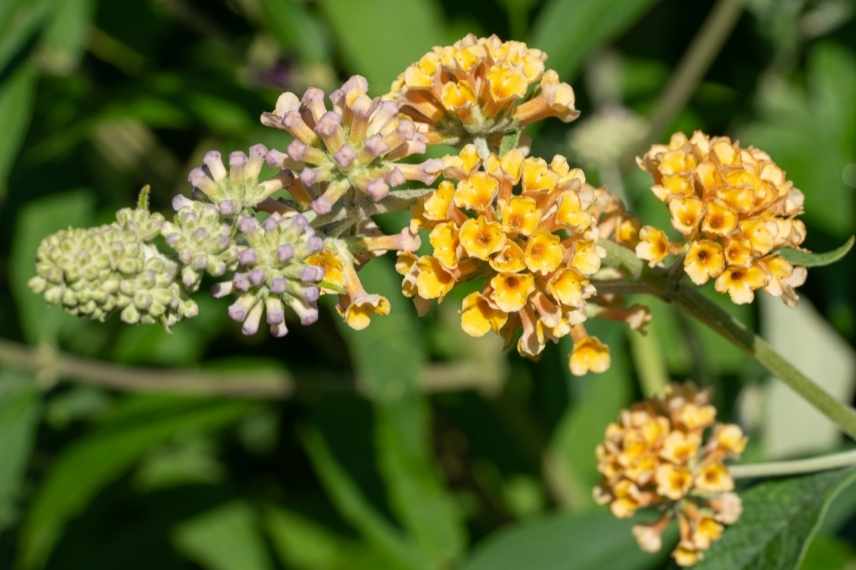
Buddleia x weyeriana ‘Sungold’
Buddleia colvilei
Native to the Himalayas, the Buddleia colvilei is a small bush with a spreading and irregular habit, charming and still relatively unknown. Yet it has many advantages: first of all, its superb Indian pink flowers, grouped in trailing terminal panicles 15 to 20 cm long. Its flowers are the largest in the genus Buddleias, displaying a nearly exotic look with their rich hue and shape resembling large clusters reminiscent of weigela. The Buddleia colvilei blooms as early as June, on the shoots of the previous year. The lush foliage adds to this exotic appearance: the leaves are lanceolate, very finely dentate, and dark green in colour. The bush typically grows between 3m and 4m in height and is best planted in gardens sheltered from severe frosts, as it is sensitive to temperatures below -10°C. In any case, ideally position it at the foot of a sunny wall or in a well-protected spot.
→ Gwenaëlle’s advice: The cultivar ‘Kewensis’ bears inflorescences that lean towards an even more intense, incandescent red!
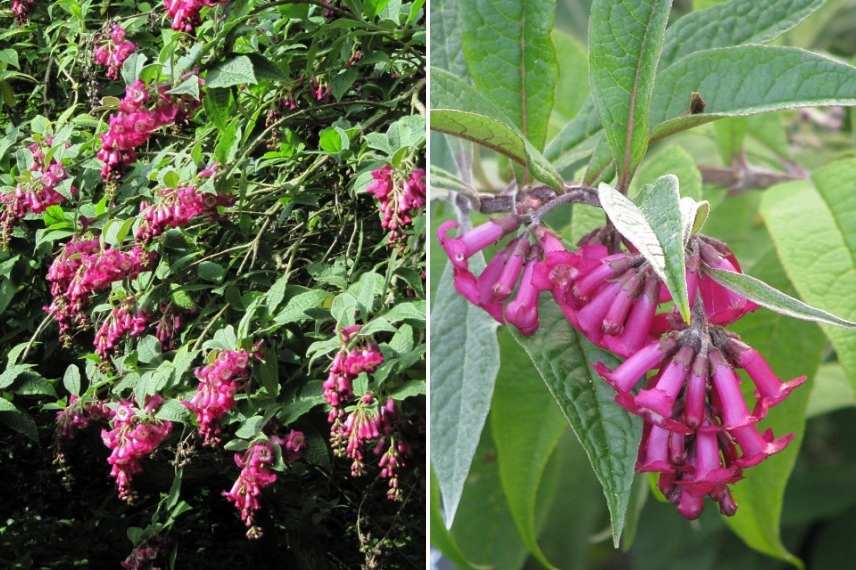
Buddleja colvilei (© Leonora Enking, Flickr) and close-up of the flower (© Peganum, Flickr)
Discover other Buddleja -Butterfly bush
View all →Available in 4 sizes
Available in 1 sizes
Available in 2 sizes
Available in 2 sizes
Available in 2 sizes
Available in 1 sizes
Available in 1 sizes
Available in 4 sizes
Available in 1 sizes
Available in 2 sizes
Buddleia globosa
This other species of buddleia also takes on an orange-yellow hue, but it is very recognisable due to a particularity in the shape of its inflorescence: Buddleia globosa bears perfectly spherical, very compact and bright terminal inflorescences, about 3 cm in diameter, in bouquets 12 to 15 cm long that stand out particularly from the foliage, reminiscent of lantana flowers. It flowers from May to June, and depending on the climate, possibly until early autumn, and forms a beautiful bushy to upright shrub, 4 to 5m high at ripeness with nearly the same spread. Native to Chile and Peru, this globose buddleia also features interesting foliage, a lovely dark green colour with well-defined veins. It is often semi-evergreen in France, deciduous in colder regions. Hardy down to -6°C, it is perfect for mixed borders, or as a free-standing hedge combined with other Buddleias, or even as a solitary plant to enjoy its unique flowering.
→ Gwenaëlle’s advice: its flowering occurs on the wood of the previous year, so prune it just after flowering.
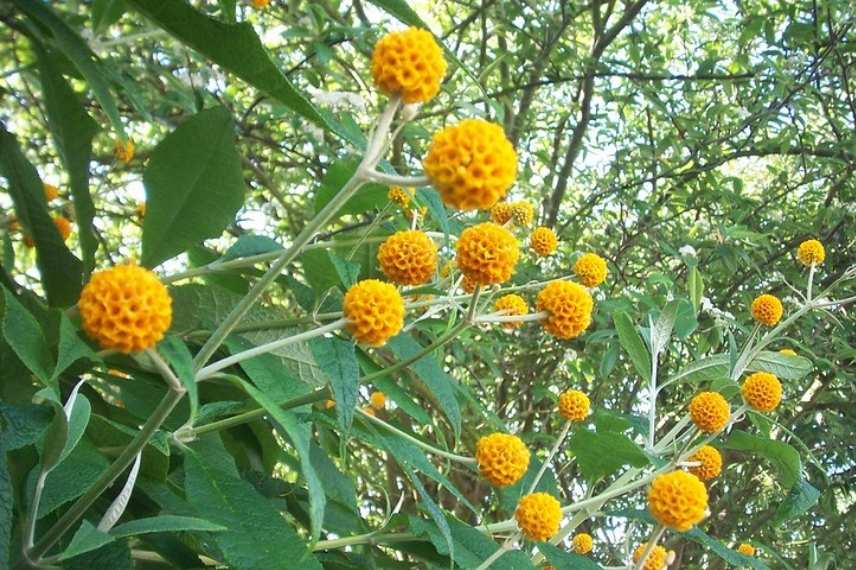
Buddleja globosa or globose buddleia (© Leonora Enking)
Read also
Which butterfly tree to choose?Buddleia ‘Silver Anniversary’
Here is a Buddleja that is primarily grown for its remarkable foliage, which has a velvety texture and a soft grey colour. The often bluish foliage of Buddleias is here truly silver, with a hint of bluish white, stunning! Its all-soft leaves are particularly lanceolate. ‘Silver Anniversary’ – also known as ‘Morning Mist’ – is a hybrid between Buddleia crispa and Buddleia loricata. It features a small creamy melliferous flowering with a yellow heart, tone on tone, appearing from July to October, which looks wonderful in a herbaceous border contrasting with purple or bright green foliage. It can also be planted in a pot on a sunny terrace, always in well-drained soil, but be cautious with this use as this horticultural variety is only hardy down to -7°C in open ground.
→ Gwenaëlle’s advice: Insert ‘Silver Anniversary’ into a white garden, a scree garden, a seaside garden, or a Mediterranean-style garden! As the flowers tend to turn brown quickly, it is important to remove them to allow the foliage to take precedence as soon as flowering is over. The Buddleia glomerata ‘Silver Service’ is another cultivar that stands out for its greyish to whitish foliage.

The grey foliage of Buddleja ‘Silver Anniversary’ (© Wikimedia Commons-Ptelea), and to the right, the creamy flowering (© Peganum, Flickr)
Buddleia lindleyana
Lindley’s butterfly tree or Buddleia lindleyana is a species discovered in China, highly ornamental due to its habit and flowering in very graceful paniculate clusters, more elongated than those known in other Buddleias. Small in size (growing between 1.5m and 2m tall), it has a naturally weeping arching silhouette, making it suitable for romantic, naturalistic, or country gardens. The long panicles composed of tubular flowers in a violet-blue hue almost resemble a miniature version of certain wisterias (they can measure up to 20 cm long). The bright green foliage contrasts perfectly with this intense mauve colour. More hardy than other species in this selection, you can plant Buddleia lindleyana in all regions.
→ Gwenaëlle’s advice: plant Buddleia lindleyana in a country hedge or in a border where you can enjoy its long and delicate flowering from April to October.
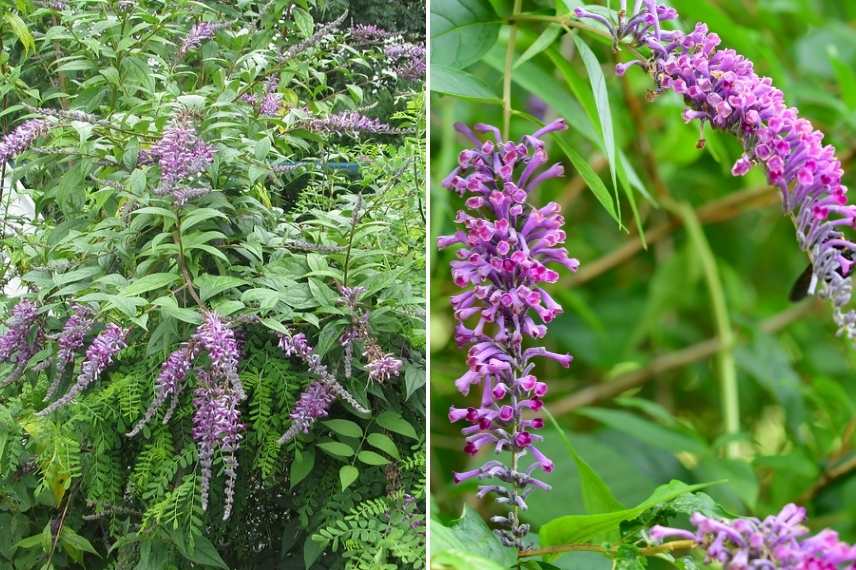
Buddleja lindleyana (© Peganum, Flickr)
Buddleia macrostachya
In the botanical rarities of butterfly trees, the Buddleia macrostachya is a true gem! It displays long mauve panicles that are absolutely delightful, each flower marked at its centre with an orange spot, giving it a lovely apricot pastel hue. Its beautiful flowers are among the most fragrant of the genus, alongside Buddleia salviifolia, and they remain on the tree until the frosts. The very large (30 cm long) and pointed leaves also provide a total escape. The bush reaches 3m in height with a similar spread; like other butterfly trees, it requires a fresh to dry but well-drained soil and a sunny position, along with special care for pot cultivation (it is, like most Buddlejas in this selection, a bit more frost-sensitive).
→ Gwenaëlle’s advice: a rare shrub, to be adopted without hesitation in a collection of Buddleias, and in exotic or English gardens, or even in a pot on a large terrace to enjoy its exceptional flowering.
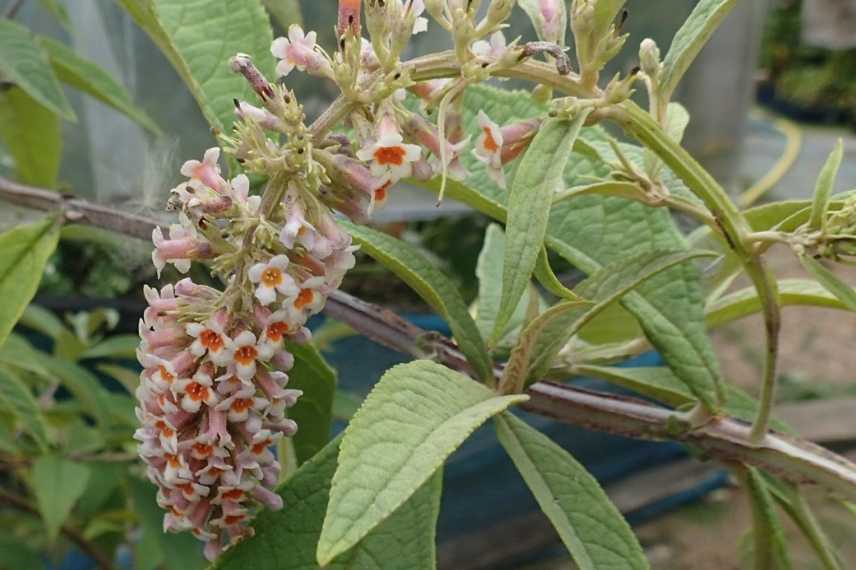
Buddleia macrostachya (© Peganum, Flickr)
And also...
Buddleias comprise over 100 species worldwide, originating from America, Africa, or Asia. This indicates that it is a particularly rich genus. Besides Buddleia davidii, the most commonly encountered here and of Chinese origin, we note Buddleia curviflora, Buddleia paniculata, and Buddleia crispa from Northern India, which is smaller and has pink tufted flowers, Buddleia salviifolia with lilac mauve and highly fragrant blooms, Buddleia madagascariensis with its stunning orange flowering, Buddleia speciosissima, Buddleia auriculensis in cream colour and later flowering, and Buddleia glomerata among the most attractive species…

Some of the butterfly trees that are also worth a visit: Buddleja speciosissima and Buddleja paniculata (© Peganum), the orange Buddleja madagascariensis (© HQ), and Buddleja salviifolia at the bottom right (© Peganum)
- Subscribe!
- Contents
































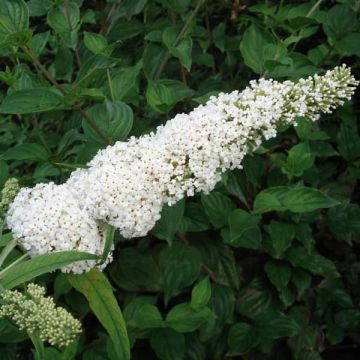
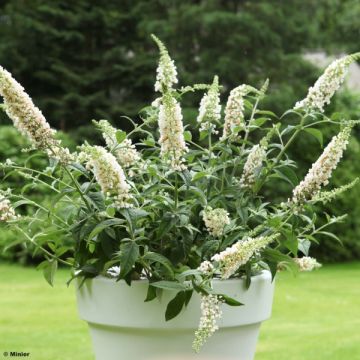

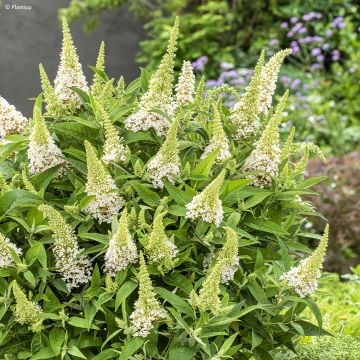
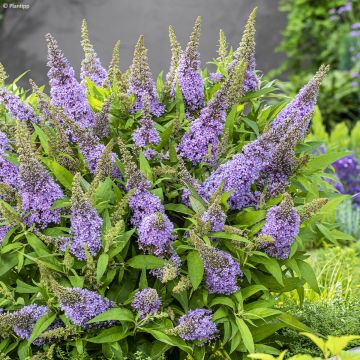
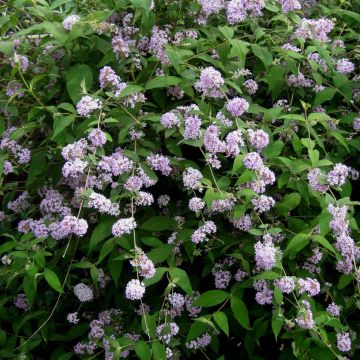
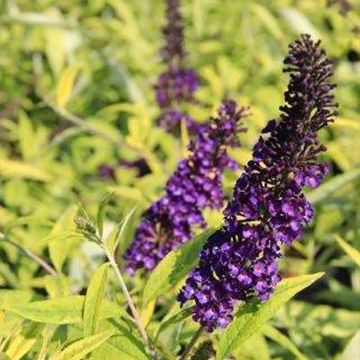
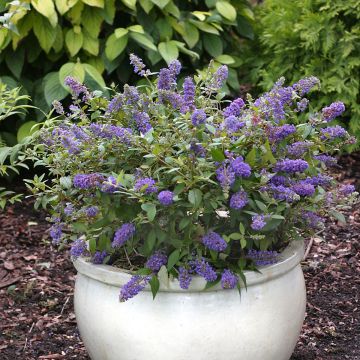


Comments